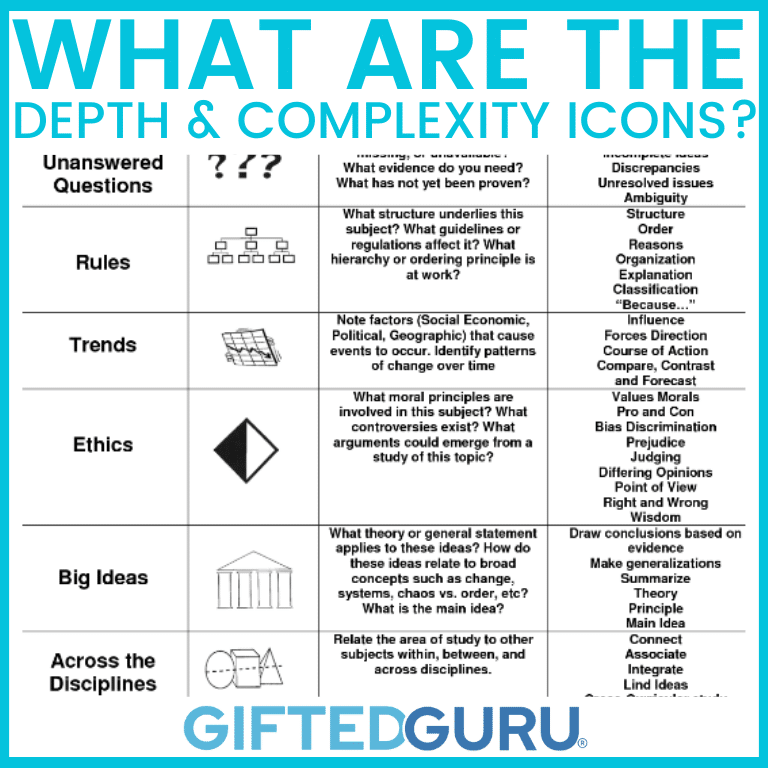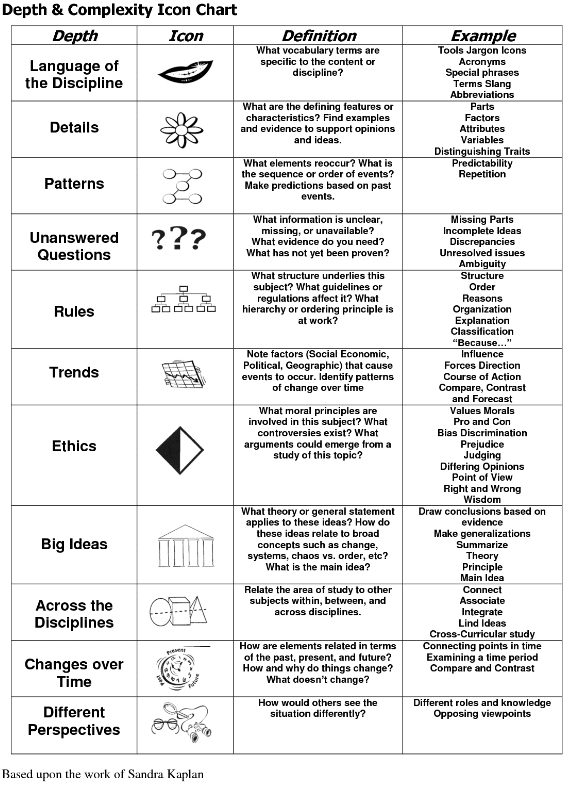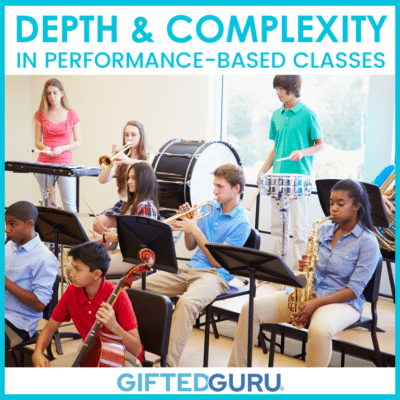The Depth and Complexity icons are a set of eleven visual prompts corresponding the the eleven fundamental thinking prompts of the Depth & Complexity framework. The icons were designed by Sheila Madsen to accompany the Depth and Complexity thinking prompts created by Dr. Sandra Kaplan and Bette Gould in the mid-90’s.
These icons were designed cue students in to the thinking that was being expected. They’re part of a larger differentiation practice that can add depth and understanding to a students’ mastery of a concept and improve their critical thinking skills.
When the Depth and Complexity framework was created over forty years ago, the set of icons designed by Sheila Madsen represent the eleven thinking prompts that are the most recognizable part of the Depth and Complexity Framework.
That set of icons still floats around the internet today, usually in charts that attempt to give an overview of the eleven thinking prompts, such as this one below.
Over time, many of the icons became dated, and some are just difficult (look at Changes over Time in the chart above to see what I mean).
John Gould, Bette’s son, owns the copyright to a revision of these icons that incorporates color and a mild modernization of several of the icons, including Across Disciplines, Multiple Perspectives, and Trends.
[You may notice that even the names vary slightly. Is it “Across the Disciplines” or just “Across Disciplines”? Is it “Different Perspectives” or “Multiple Perspective”? Those variations do not indicate a difference in meaning. They’re merely semantic.]
What are the Elements of Depth and Complexity?
The phrase “elements of Depth and Complexity” refers to the eleven thinking prompts of the Depth and Complexity framework.
They are the foundation of the framework (which also includes the Content Imperatives, Universal Themes, and Disciplinarianism).
The elements of Depth and Complexity is where teachers begin their Depth and Complexity practice.
They are easily implemented in classrooms of all ability types. In 1995, Dr. Kaplan and Ms. Gould cowrote the first public material on Depth and Complexity in a brief overview called, The Flip Book: A Quick and Easy Method for Developing Differentiated Learning Experiences.
Notice that the term “Depth and Complexity” wasn’t even in the title! The idea of quickness and ease was already there, though, and that is still the case.
The elements of Depth and Complexity are still quick and easy to implement in classrooms.
What is the Order of the Depth and Complexity Icons?
There are eleven thinking prompts, each represented by an image.
Eight of them are “Depth” elements that allow students to deepen their understanding of concepts and content.
Three of them are “Complexity” elements that support students in developing stronger critical thinking regarding the content and concepts.
The eight Depth elements are often arranged in order from those that indicate more concrete aspects of content (like definitions) to those that indicate more abstract aspects of content (like what we can say about a topic after having learned a lot about it).
Eventually, we help students arrive at an understanding that our content connects with many other aspects of learning and life. (That’s the Across Disciplines thinking prompt).
The order is not important in classrooms, other than to keep in mind that you wouldn’t want students only looking at content through one lens of the framework.
It’s important to note that the icons are not the important thing. The important thing is the thinking represented by the icons. The thinking prompt is what’s important. The images exist to indicate the thinking prompt.
The Depth Thinking Prompts of Depth and Complexity
If you’d like a quick run-down of the eleven thinking prompts, here are brief explanations of them.
Details:
Details is the thinking prompt of the specifics of a thing. What makes this thing what it is? What is different, unique, or special about it? What differentiates it from other, similar things? Which details are important or relevant or irrelevant? What details become important later? Which details can be safely ignored?
Language of the Discipline:
The Language of the Discipline includes the academic vocabulary of a piece of content, and it’s also tools and people associated with it. Protractors and Vasco de Gama? Both are Language of the Discipline
Patterns:
All cycles are Patterns – life cycle of the plant, the rock cycle, etc. Anything that can be predicted, anything that repeats, and anything that has a rhythm is Patterns. We see patterns in every single content area. In Language Arts, archetype and plot are pattern. Migration is pattern. Math is Patterns + Rules.
Unanswered Questions:
It’s not “What do you still want to know?” It’s asking what cannot be known. It’s asking what resources we have and what we lack. It’s asking how two people, with the same set of facts, can come to completely different conclusions. I love this prompt, and I wish people used it more effectively.
Rules:
Rules includes the “must-do” ideas, of course. But it’s deeper than that. It’s the way things are organized, the methods we follow, the directions we follow, the way things usually behave, and standards (like standards of weights and measures).
Trends:
This is the cause and effect element, so it’s very handy. It looks at the direction something is heading. Remember: statis is a Trend, so don’t be fooled into thinking that Trends must have up or down directionality. It not only looks at a direction, but what are the forces acting on it to push it in that direction?
Ethics:
This is the pros and cons element. Yes, it’s fairness, justice, philosophy, and dilemma. It’s also looking at problems and (hopefully) solutions.
Big Idea:
Big Idea is what you can say about a piece of content or a concept after learning about it and analyzing it. It is a culminating element. It’s not the topic; it’s what you can say about the topic after having spent quality time with it.
Complexity Elements of Depth and Complexity
Across Disciplines:
Across Disciplines is both inter- and intra-disciplinary. This means you can look at content across other disciplines, as well across the discipline you’re in.
Change over Time:
This is the thinking prompt of past, present, and future. What was this like? What is it like now? How do we think it will be in the future? Why is it important to consider this? What impact does the past have on it now?
Multiple Perspectives:
Things can look very different to different people. You see this in literature, of course, but you open your mind to its truest possibilities when you use it with inanimate objects as well. How does the Earth feel about tide? Describe the Bantu migration from the perspective of the savanna. Which cares more about the balancing of the equation, the numbers or the equals sign?
Why ⚖️ Emoji are Perfect for the Depth and Complexity Icons
Typically, when people refer to the Depth and Complexity icons, they mean the revision done that includes colored backgrounds.
When Ian Byrd and I wrote Gifted Guild’s Guide to Depth and Complexity, we moved away from these and into emoji (at the recommendation of Ian’s talented wife, Mary).
Originally this was because Mr. Gould would not allow us to use the icons. However, as necessity is the mother of invention, we quickly realized that emoji were superior for our purposes.
Here are some of the advantages of using emoji:
- Ease of Use: There are emoji browser extensions and Microsoft Office Add-ons that make using them a breeze. No copying and pasting of jpegs! Simply insert and boom! You’re off. This has saved us so much time.
- Student Familiarity: Our students are used to emoji. They use them every day. They see them every day. As opposed to learning a complete set of unfamiliar pictures, they quickly pick up the idea of the emoji we’re using because they’ve seen them before.
- Attention-Grabbing: Emojis can make a message stand out in a sea of text. The ease of inserting emoji in a task statement or sentence helps students hone in on what we’re doing.
- Flexible: With emoji, you can change them if you needed to. Currently, I use the 🌀cyclone emoji for patterns to indicate “cycle,” but it’s possible a better one will come along.
- Youthful Appeal: Emojis are add a more informal and youthful tone to the thinking prompts. This can make the Depth and Complexity framework feel more approachable and relatable.
What Emoji Do You Use for Depth and Complexity`?
Here are the emoji I use to represent the Depth and Complexity thinking prompts. I’ve separated them into Depth elements and Complexity elements, but keep in mind that I don’t worry about that in my teaching practice.
Depth Elements of Depth and Complexity
Details:
For Details, I use the 🍃leaf emoji. I do this because I use a tree for Big Idea, and I like the imagery of a bunch of Details making up a Big Idea.
Language of the Discipline:
Could there be anything other than a mouth 👄 for this one? I don’t think so!
Patterns:
As mentioned above, I use the 🌀cyclone emoji for Patterns. 🌀Patterns can be predicted, and I love the connection to how we can predict cyclones, but they can still veer off course. The same is true of 🌀Patterns.
Unanswered Questions:
A single question mark ❓ is the emoji I use for Unanswered Questions.
Rules:
This is one where I feel like the emoji is so much better than the icon! I use the stoplight emoji 🚦for this. I love how we can have red Rules (do not break me!), yellow Rules (be careful!), and green Rules (yes, I’m a rule, but if you break me, nothing terrible will happen).
Trends:
Trends is so simple. It’s exactly what you see in your mind 📈.
Ethics:
I use the scales emoji ⚖️ for Ethics. We use ⚖️Ethics to weigh the pros and cons, so this is perfect! Ethics is justice and fairness, both of which this emoji represents beautifully.
Big Idea:
You already know why I use a 🌳tree emoji for Big Idea. We put all those 🍃Details together and we’ve got this tree. I love this combo!!!
Complexity Elements of Depth and Complexity
Across Disciplines:
For Across Disciplines, the 📚 stacked books emoji is perfect. I like how the different colors can represent different disciplines.
Change over Time:
The hour glass/sand timer emoji ⏳is so handy. There’s even a ⌛variation where there’s more sand on the bottom than the top. That’s handy!
Multiple Perspectives:
You could use regular glasses for this, but I like 🕶️sunglasses. Partly this is because they have a little coolness factor that I like, but also because they’re easier to sketch out for me, as I tend to blotch my ink a little bit.
Learning More about Depth and Complexity
I’ve got three ways for you to learn more about Depth and Complexity:
- You can read everything I’ve written about Depth and Complexity here.
- You can find the definitive book about Depth and Complexity here (on Amazon).
- You can take my (fabulous!) course on Depth and Complexity. Learn more here.







